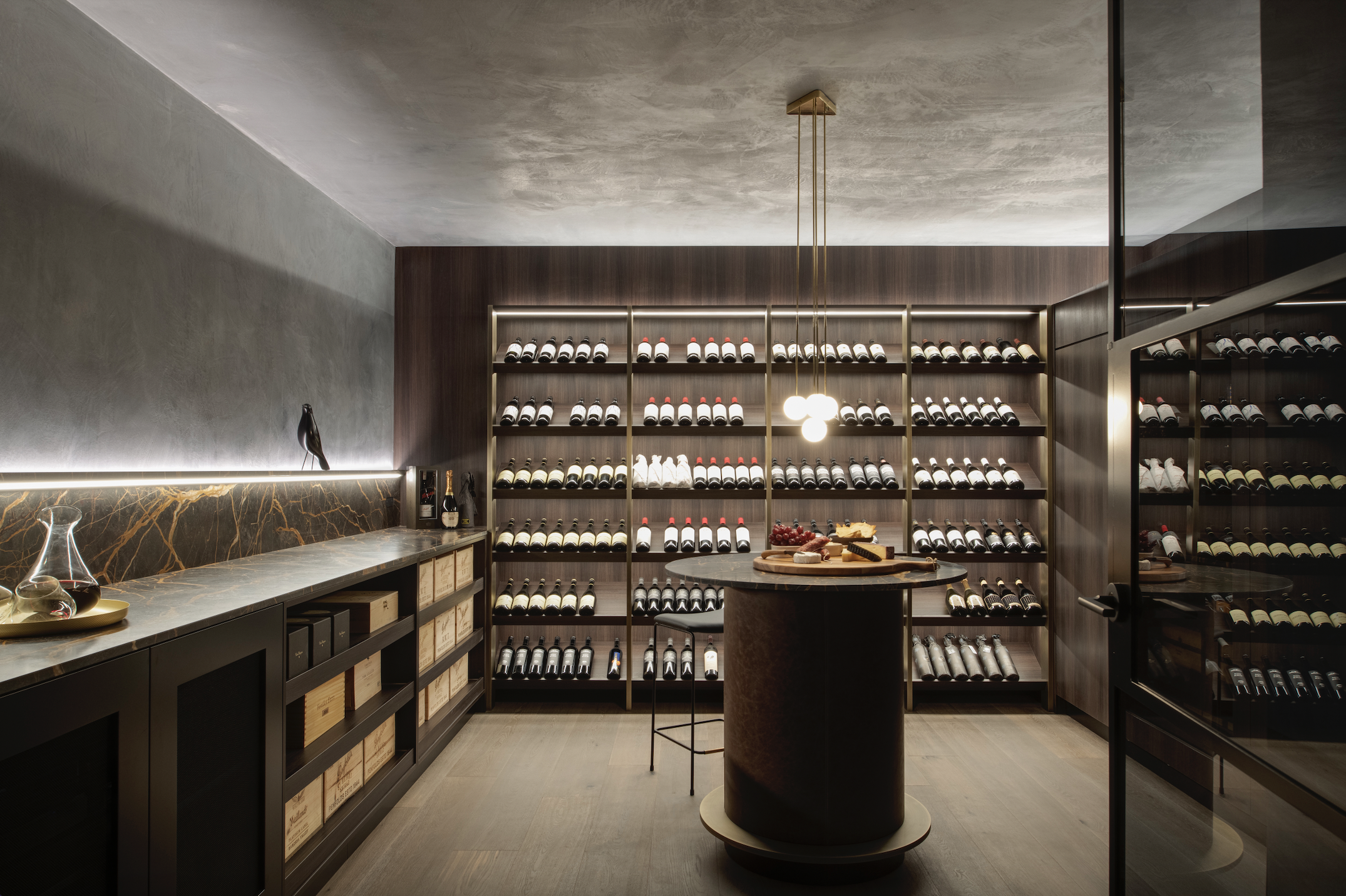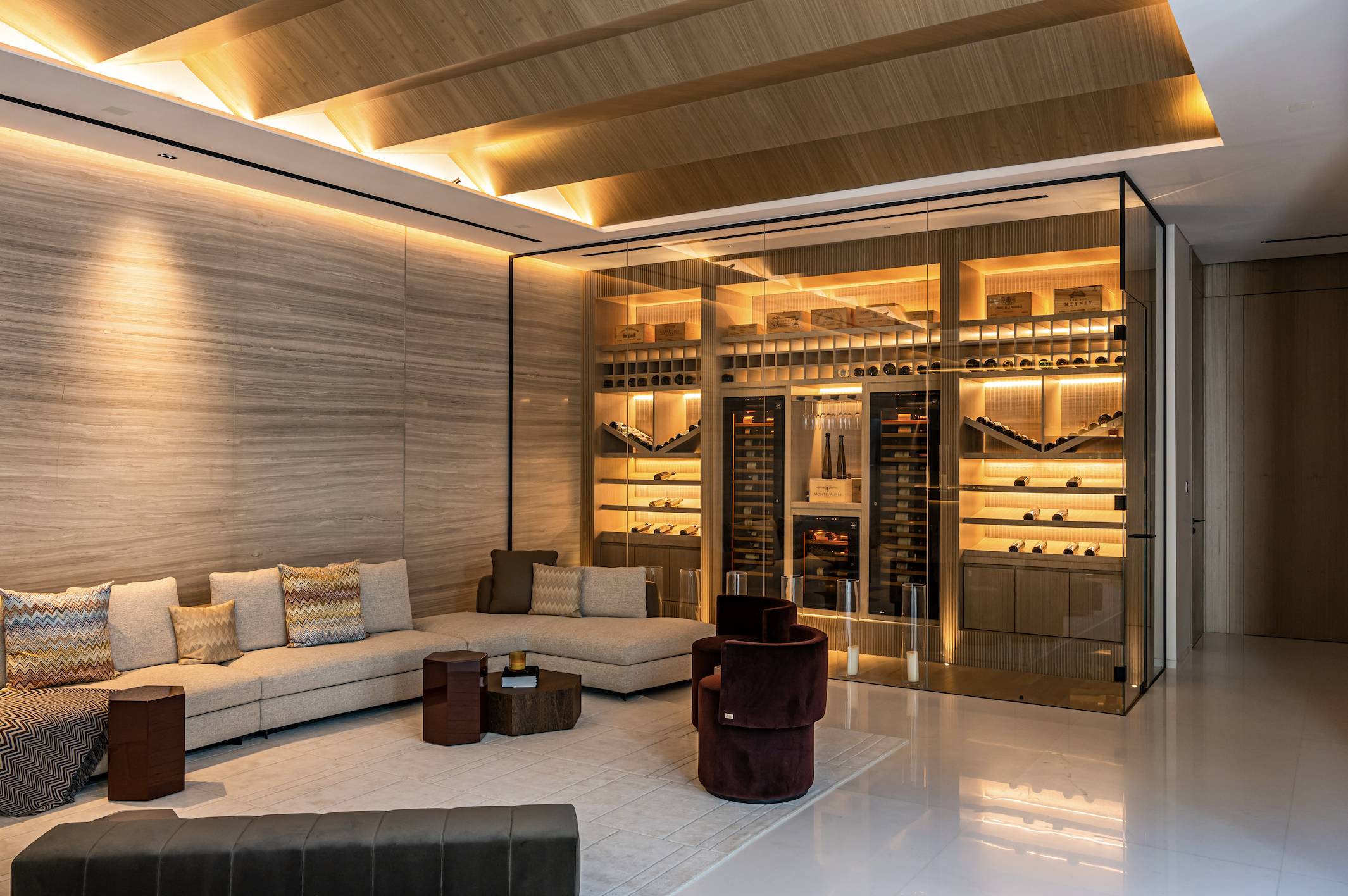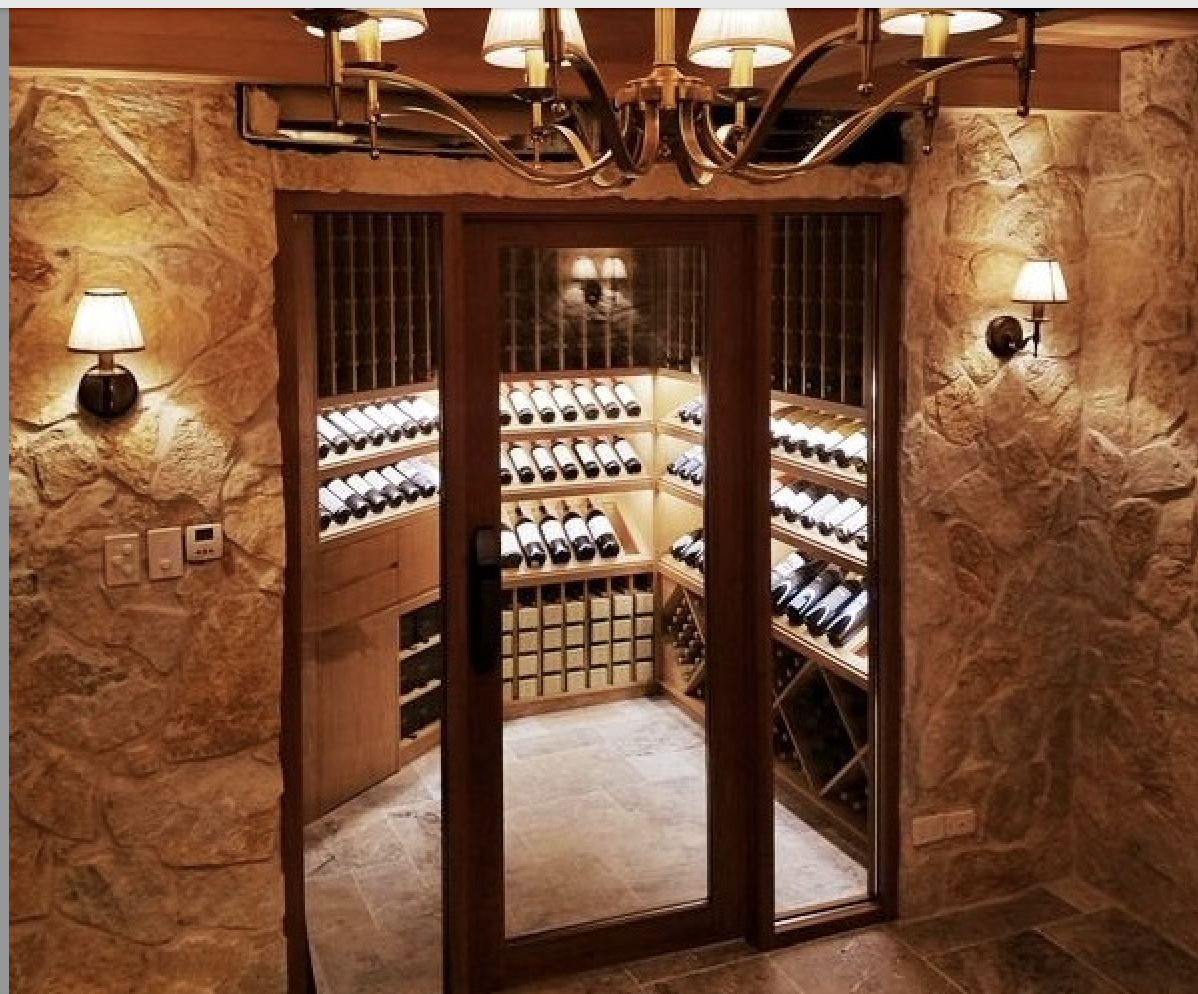The stairway to heaven for wine lovers
Home cellars have become the latest must-have for those who value their collection and love to entertain
Tony Hayek first became interested in wine as a student at Newcastle University. Living adjacent to one of Australia’s best known wine growing regions, the Hunter Valley, for a while he dated a woman who worked in the industry and taught him what she knew.
He has been hooked ever since.
“Over the next 25 years, I collected wine in drinkable quantities,” he says. “As I became wealthier, I started buying wine in batches of six — I’d drink one or two and put the others away — but I didn’t really have anywhere to store them so it capped out at 300 or 400 bottles.”
In his former home, he turned a workshop under the house into a wine cellar of sorts. It wasn’t temperature controlled but it allowed him to enjoy his wine when and where he wanted. But when he and his wife Toni had the chance to build their dream home in Sydney’s north west in 2017, plans for a cellar were a bit basic.
“The builder engaged a cabinetmaker to put together a plan for a wine cellar but it was a bit boring — mostly just shelving,” Hayek says.
Instead, the couple hired kitchen and bathroom design specialists, Studio Minosa.
“They did this magnificent design,” Hayek says. “I was still recovering from the cost of building when the Minosa quote came in at $150,000 so I initially put it on the backburner. Finally, I bit the bullet and we got it done in 2020.”
As a result, Hayek says much of his time at home during the pandemic was spent below ground.

“It’s my ‘pinch myself’ room,” he says. “Every time I walk in there, I can’t believe it’s in my house. I spent a lot of my COVID time researching wine. That was how I stocked my cellar and it went from 400 to 800 bottles. I want to know what’s in my cellar and have a relationship with it.”
While Tania MacPhee, managing director of MacPhee’s wine cellaring specialists, says wine cellars were becoming more popular prior to the pandemic, demand grew even further during lockdown when people used their untapped travel funds to create wine spaces they could enjoy.
“We started as an off-site wine storage business 22 years ago. Since then, the market has absolutely shifted,” she says. “Where wine cellars back then were predominately functional spaces in the basement or garage, today, wine enthusiasts are wanting to proudly display their wine collections, making them a feature of their home.”
She says the demand for purpose-built cellars has been driven by an educated audience who travel regularly and appreciate the value of a good drop. For those who have invested heavily, it’s important to keep wines in optimum conditions.
The challenge is maintaining an even temperature range to avoid wine “spoiling”, which alters its taste, smell and the consumer’s overall enjoyment. In wine making regions in Europe, the ideal temperature range around 12 to 14 degrees may be achievable without refrigeration due to their cellars being two metres below the earth, but MacPhee says it’s virtually impossible to guarantee in Australia where our cellar spaces are often beside a garage and under a concrete slab, acting as a hot box in summer — and a freezer in winter. “It’s the fluctuation in temperature that is detrimental to wine.”
“While a basement might seem cool at 26 degrees compared with hot Summer temperatures outside, it’s still not cool enough for wine,” she says.
For those who don’t have the space for a full cellar, or would rather have their wines on display, MacPhee says ‘wine walls’ are a popular choice.
“People are going to beautiful restaurants where they have these wine walls where guests can see individual bottles of wine,” she says. “And they want to recreate that in their homes.”
Wine walls are typically two or three metres wide and at least 600mm deep, she says.

“Depending on the location of the wine cellar relative to the rest of the home, $20,000 is the starting point for a very basic climate controlled space with insulation,” she says. “A wine wall with bespoke cabinetry can cost between $80,000 and $100,000 or more.”
“All wine needs to be cellared at the same temperature but when it comes to drinking, it is only then that individual wine varietals should be served at different temperatures”, MacPhee says. Some wine fridges provide two temperatures, in two separate zones. There’s even an under bench wine cabinet which is designed for the kitchen.
“It has multiple temperatures all in one zone, where you can place champagne at the bottom at six degrees, then Aromatic whites on the shelf above at 8 degrees, then it gradually goes up to 18 degrees for your heavy bodied reds.” she says. “We call it the ‘instant gratification wine cabinet’.”
General manager at Gaggenau, Robert Warner says wine lovers are investing in larger quantities of high quality wines so it simply makes sense that they are looking for accessible storage options at home.
“If you are buying a $100 bottle of wine and then you decide to buy the whole case, that’s $1200,” he says. “Do you want to risk it going off in a year or two because you haven’t stored it properly?”
He admits there is more to it than having your favourite drop within easy reach and ready to drink.
“There’s a bit of theatre to it,” he says. “It’s a lifestyle and interaction with like-minded people. Luxury living is about being personalised while still feeling connected with other people.”
This stylish family home combines a classic palette and finishes with a flexible floorplan
Just 55 minutes from Sydney, make this your creative getaway located in the majestic Hawkesbury region.
Ahead of the Games, a breakdown of the city’s most desirable places to live
PARIS —Paris has long been a byword for luxurious living. The traditional components of the upscale home, from parquet floors to elaborate moldings, have their origins here. Yet settling down in just the right address in this low-rise, high-density city may be the greatest luxury of all.
Tradition reigns supreme in Paris real estate, where certain conditions seem set in stone—the western half of the city, on either side of the Seine, has long been more expensive than the east. But in the fashion world’s capital, parts of the housing market are also subject to shifting fads. In the trendy, hilly northeast, a roving cool factor can send prices in this year’s hip neighborhood rising, while last year’s might seem like a sudden bargain.
This week, with the opening of the Olympic Games and the eyes of the world turned toward Paris, The Wall Street Journal looks at the most expensive and desirable areas in the City of Light.
The Most Expensive Arrondissement: the 6th
Known for historic architecture, elegant apartment houses and bohemian street cred, the 6th Arrondissement is Paris’s answer to Manhattan’s West Village. Like its New York counterpart, the 6th’s starving-artist days are long behind it. But the charm that first wooed notable residents like Gertrude Stein and Jean-Paul Sartre is still largely intact, attracting high-minded tourists and deep-pocketed homeowners who can afford its once-edgy, now serene atmosphere.
Le Breton George V Notaires, a Paris notary with an international clientele, says the 6th consistently holds the title of most expensive arrondissement among Paris’s 20 administrative districts, and 2023 was no exception. Last year, average home prices reached $1,428 a square foot—almost 30% higher than the Paris average of $1,100 a square foot.
According to Meilleurs Agents, the Paris real estate appraisal company, the 6th is also home to three of the city’s five most expensive streets. Rue de Furstemberg, a secluded loop between Boulevard Saint-Germain and the Seine, comes in on top, with average prices of $2,454 a square foot as of March 2024.
For more than two decades, Kyle Branum, a 51-year-old attorney, and Kimberly Branum, a 60-year-old retired CEO, have been regular visitors to Paris, opting for apartment rentals and ultimately an ownership interest in an apartment in the city’s 7th Arrondissement, a sedate Left Bank district known for its discreet atmosphere and plutocratic residents.
“The 7th was the only place we stayed,” says Kimberly, “but we spent most of our time in the 6th.”
In 2022, inspired by the strength of the dollar, the Branums decided to fulfil a longstanding dream of buying in Paris. Working with Paris Property Group, they opted for a 1,465-square-foot, three-bedroom in a building dating to the 17th century on a side street in the 6th Arrondissement. They paid $2.7 million for the unit and then spent just over $1 million on the renovation, working with Franco-American visual artist Monte Laster, who also does interiors.
The couple, who live in Santa Barbara, Calif., plan to spend about three months a year in Paris, hosting children and grandchildren, and cooking after forays to local food markets. Their new kitchen, which includes a French stove from luxury appliance brand Lacanche, is Kimberly’s favourite room, she says.
Another American, investor Ashley Maddox, 49, is also considering relocating.
In 2012, the longtime Paris resident bought a dingy, overstuffed 1,765-square-foot apartment in the 6th and started from scratch. She paid $2.5 million and undertook a gut renovation and building improvements for about $800,000. A centrepiece of the home now is the one-time salon, which was turned into an open-plan kitchen and dining area where Maddox and her three children tend to hang out, American-style. Just outside her door are some of the city’s best-known bakeries and cheesemongers, and she is a short walk from the Jardin du Luxembourg, the Left Bank’s premier green space.
“A lot of the majesty of the city is accessible from here,” she says. “It’s so central, it’s bananas.” Now that two of her children are going away to school, she has listed the four-bedroom apartment with Varenne for $5 million.
The Most Expensive Neighbourhoods: Notre-Dame and Invalides
Garrow Kedigian is moving up in the world of Parisian real estate by heading south of the Seine.
During the pandemic, the Canada-born, New York-based interior designer reassessed his life, he says, and decided “I’m not going to wait any longer to have a pied-à-terre in Paris.”
He originally selected a 1,130-square-foot one-bedroom in the trendy 9th Arrondissement, an up-and-coming Right Bank district just below Montmartre. But he soon realised it was too small for his extended stays, not to mention hosting guests from out of town.
After paying about $1.6 million in 2022 and then investing about $55,000 in new decor, he put the unit up for sale in early 2024 and went house-shopping a second time. He ended up in the Invalides quarter of the 7th Arrondissement in the shadow of one Paris’s signature monuments, the golden-domed Hôtel des Invalides, which dates to the 17th century and is fronted by a grand esplanade.
His new neighbourhood vies for Paris’s most expensive with the Notre-Dame quarter in the 4th Arrondissement, centred on a few islands in the Seine behind its namesake cathedral. According to Le Breton, home prices in the Notre-Dame neighbourhood were $1,818 a square foot in 2023, followed by $1,568 a square foot in Invalides.
After breaking even on his Right Bank one-bedroom, Kedigian paid $2.4 million for his new 1,450-square-foot two-bedroom in a late 19th-century building. It has southern exposures, rounded living-room windows and “gorgeous floors,” he says. Kedigian, who bought the new flat through Junot Fine Properties/Knight Frank, plans to spend up to $435,000 on a renovation that will involve restoring the original 12-foot ceiling height in many of the rooms, as well as rescuing the ceilings’ elaborate stucco detailing. He expects to finish in 2025.
Over in the Notre-Dame neighbourhood, Belles demeures de France/Christie’s recently sold a 2,370-square-foot, four-bedroom home for close to the asking price of about $8.6 million, or about $3,630 a square foot. Listing agent Marie-Hélène Lundgreen says this places the unit near the very top of Paris luxury real estate, where prime homes typically sell between $2,530 and $4,040 a square foot.
The Most Expensive Suburb: Neuilly-sur-Seine
The Boulevard Périphérique, the 22-mile ring road that surrounds Paris and its 20 arrondissements, was once a line in the sand for Parisians, who regarded the French capital’s numerous suburbs as something to drive through on their way to and from vacation. The past few decades have seen waves of gentrification beyond the city’s borders, upgrading humble or industrial districts to the north and east into prime residential areas. And it has turned Neuilly-sur-Seine, just northwest of the city, into a luxury compound of first resort.
In 2023, Neuilly’s average home price of $1,092 a square foot made the leafy, stately community Paris’s most expensive suburb.
Longtime residents, Alain and Michèle Bigio, decided this year is the right time to list their 7,730-square-foot, four-bedroom townhouse on a gated Neuilly street.
The couple, now in their mid 70s, completed the home in 1990, two years after they purchased a small parcel of garden from the owners next door for an undisclosed amount. Having relocated from a white-marble château outside Paris, the couple echoed their previous home by using white- and cream-coloured stone in the new four-story build. The Bigios, who will relocate just back over the border in the 16th Arrondissement, have listed the property with Emile Garcin Propriétés for $14.7 million.
The couple raised two adult children here and undertook upgrades in their empty-nester years—most recently, an indoor pool in the basement and a new elevator.
The cool, pale interiors give way to dark and sardonic images in the former staff’s quarters in the basement where Alain works on his hobby—surreal and satirical paintings, whose risqué content means that his wife prefers they stay downstairs. “I’m not a painter,” he says. “But I paint.”
The Trendiest Arrondissement: the 9th
French interior designer Julie Hamon is theatre royalty. Her grandfather was playwright Jean Anouilh, a giant of 20th-century French literature, and her sister is actress Gwendoline Hamon. The 52-year-old, who divides her time between Paris and the U.K., still remembers when the city’s 9th Arrondissement, where she and her husband bought their 1,885-square-foot duplex in 2017, was a place to have fun rather than put down roots. Now, the 9th is the place to do both.
The 9th, a largely 19th-century district, is Paris at its most urban. But what it lacks in parks and other green spaces, it makes up with nightlife and a bustling street life. Among Paris’s gentrifying districts, which have been transformed since 2000 from near-slums to the brink of luxury, the 9th has emerged as the clear winner. According to Le Breton, average 2023 home prices here were $1,062 a square foot, while its nearest competitors for the cool crown, the 10th and the 11th, have yet to break $1,011 a square foot.
A co-principal in the Bobo Design Studio, Hamon—whose gut renovation includes a dramatic skylight, a home cinema and air conditioning—still seems surprised at how far her arrondissement has come. “The 9th used to be well known for all the theatres, nightclubs and strip clubs,” she says. “But it was never a place where you wanted to live—now it’s the place to be.”
With their youngest child about to go to college, she and her husband, 52-year-old entrepreneur Guillaume Clignet, decided to list their Paris home for $3.45 million and live in London full-time. Propriétés Parisiennes/Sotheby’s is handling the listing, which has just gone into contract after about six months on the market.
The 9th’s music venues were a draw for 44-year-old American musician and piano dealer, Ronen Segev, who divides his time between Miami and a 1,725-square-foot, two-bedroom in the lower reaches of the arrondissement. Aided by Paris Property Group, Segev purchased the apartment at auction during the pandemic, sight unseen, for $1.69 million. He spent $270,000 on a renovation, knocking down a wall to make a larger salon suitable for home concerts.
During the Olympics, Segev is renting out the space for about $22,850 a week to attendees of the Games. Otherwise, he prefers longer-term sublets to visiting musicians for $32,700 a month.
Most Exclusive Address: Avenue Junot
Hidden in the hilly expanses of the 18th Arrondissement lies a legendary street that, for those in the know, is the city’s most exclusive address. Avenue Junot, a bucolic tree-lined lane, is a fairy-tale version of the city, separate from the gritty bustle that surrounds it.
Homes here rarely come up for sale, and, when they do, they tend to be off-market, or sold before they can be listed. Martine Kuperfis—whose Paris-based Junot Group real-estate company is named for the street—says the most expensive units here are penthouses with views over the whole of the city.
In 2021, her agency sold a 3,230-square-foot triplex apartment, with a 1,400-square-foot terrace, for $8.5 million. At about $2,630 a square foot, that is three times the current average price in the whole of the 18th.
Among its current Junot listings is a 1930s 1,220-square-foot townhouse on the avenue’s cobblestone extension, with an asking price of $2.8 million.
This stylish family home combines a classic palette and finishes with a flexible floorplan
Just 55 minutes from Sydney, make this your creative getaway located in the majestic Hawkesbury region.


















